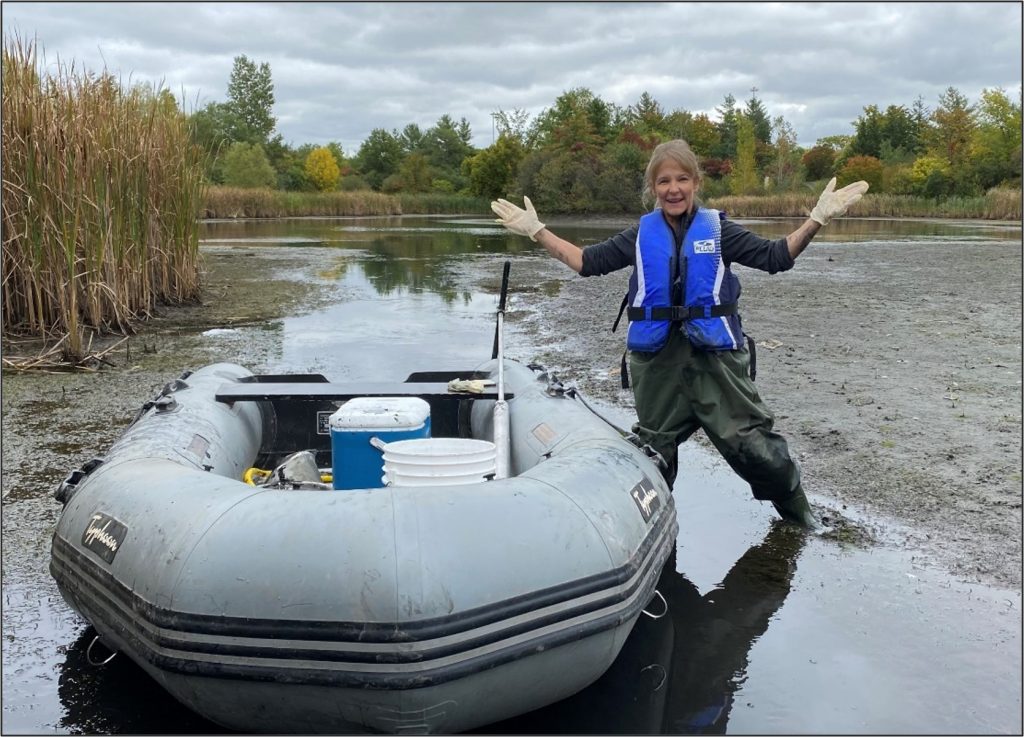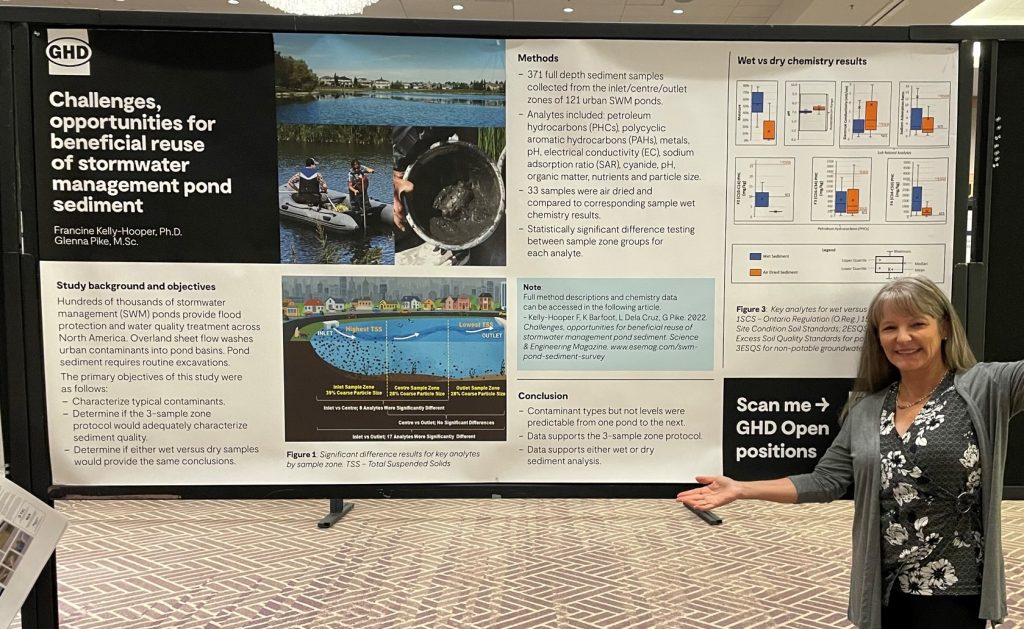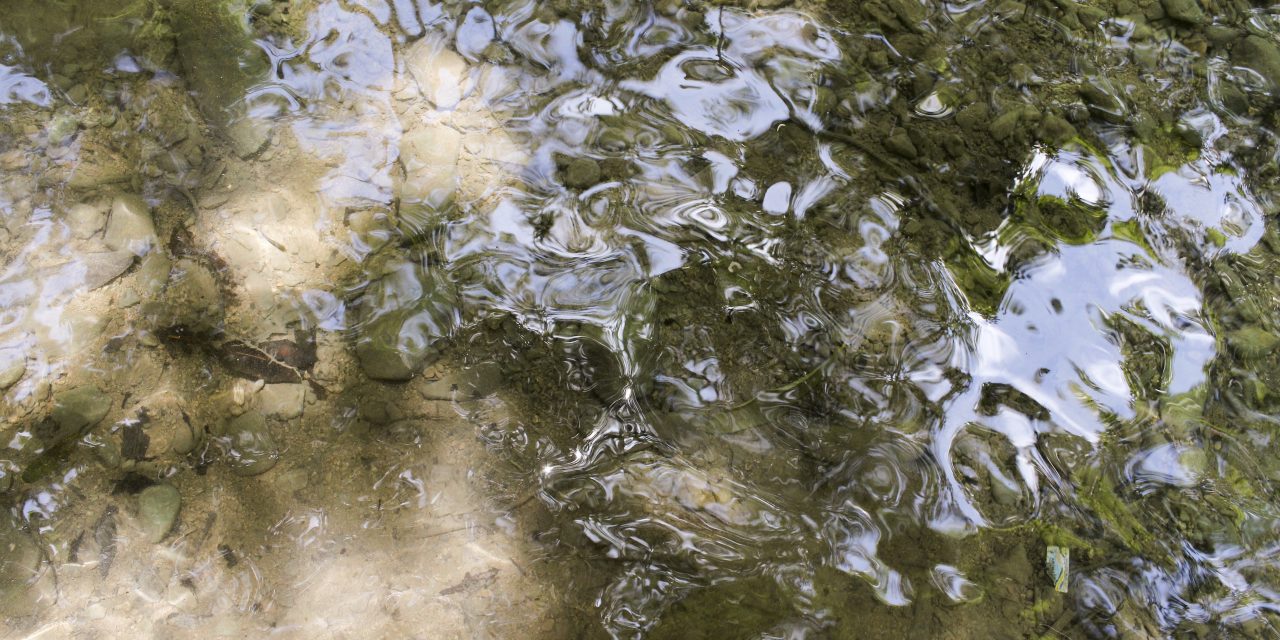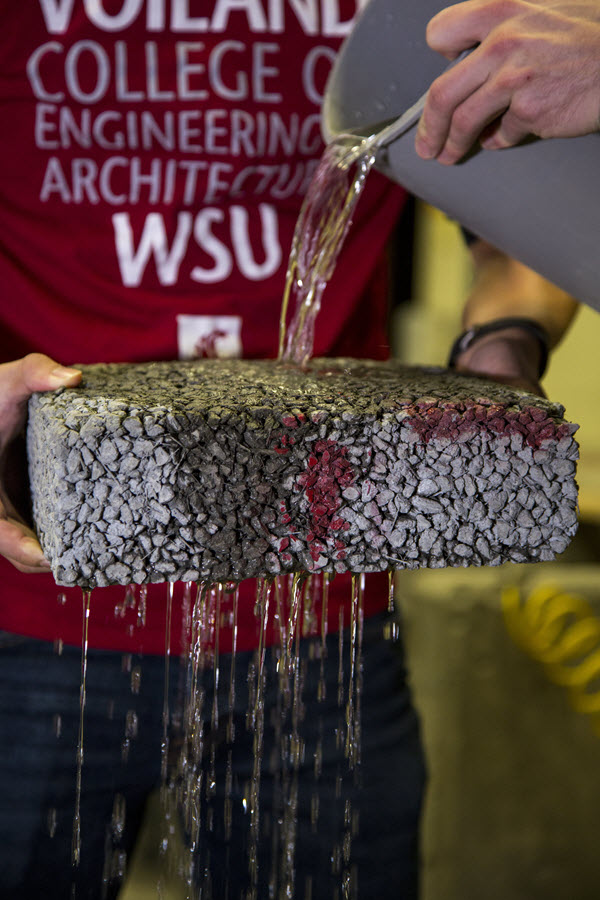Typically, removing sediments that accumulate at the bottom of stormwater management ponds represents one of the greatest headaches involved with maintaining them. This routine cleanout process, which is crucial to the proper function of stormwater ponds, often entails excessive expense. Not only must pond owners pay to dredge and transport these sediments, but they also must pay steep fees to dispose of the sediment in landfills.
Francine Kelly-Hooper, Ph.D., an Ontario, Canada-based expert in contaminant forensics, has devoted nearly 20 years of her career toward searching for a better solution. Since 2004, Kelly-Hooper has investigated stormwater pond sediments. Her research stretches across Canada and beyond to identify the substances sediments contain, the human and ecological risks these substances may present, and ultimately whether landfilling sediments is the only safe management option.
Her findings have shown that stormwater pond sediments often are not the unpredictable cocktail of contaminants they are often assumed to be. These sediments even may lend themselves to opportunities for beneficial reuse.
By demonstrating the safety of reusing sediments under the right circumstances, Kelly-Hooper and her partners have thus far earned regulatory approvals for five sediment reuse projects in Ontario — the only known approvals of their kind in Canada and beyond.
“When I started this work, the only question people had was ‘Can we avoid hazardous waste disposal?’” Kelly-Hooper said. “There was this assumption that stormwater pond sediments contained unpredictable contaminant mixtures, but what we found was that they typically contain road salt and asphalt pavement particles with low metal concentrations.”
A Hidden Financial Crisis
As stormwater ponds became a common tactic to sequester runoff and prevent urban flooding only around the 1990s, it took several years before the effects of sediment accumulation on their function became apparent. In the early 2000s, Kelly-Hooper’s home city of Waterloo, Ontario, became one of the first municipalities in Canada to investigate sediment removal logistics for its 40+ stormwater ponds. The city contacted Kelly-Hooper, then an independent consultant, to assess the substances these sediments contained as well as estimate total disposal costs.

“Once we got the results back, we realized that Waterloo was going to have to pay [CAD] $40,000 for just one pond, but the money was not set aside for it at that time,” Kelly-Hooper said. “The city managers did the math and realized they were going to lose about $10 million for all of their ponds combined, and it caused a big, chaotic reaction. I was worried about how this loss could affect the locally funded social programs in my city.”
Those kinds of numbers for a single, mid-sized city made Kelly-Hooper wonder about the magnitude of an imminent — and underrecognized — expense for cities elsewhere as more stormwater ponds began showing signs of impairment. She described her concerns in a letter to Ontario’s Ministry of Environment, Conservation, and Parks (MECP), who responded with a grant of $60,000 to further investigate the scope of the issue. Next, she called environmental representatives around the country, which resulted in 22 cities in five provinces providing matching funds to conduct a nationwide inquiry of sediment chemistry.
Ever since, Kelly-Hooper has been compiling a public database of contaminants discovered in stormwater pond sediments across Canada, as well as performing research to better understand the potential ecotoxicity of these contaminants. The database currently details findings from 371 sediment samples drawn from 121 urban stormwater ponds.
Science Beneath the Surface
Particularly in the urban areas in which Kelly-Hooper typically conducts her research, roadways are a major source of the runoff that ultimately enters stormwater ponds. Her investigation illustrates that petroleum hydrocarbons (PHCs) from asphalt particles are consistently the most prevalent potential contaminant entrained in urban stormwater pond sediment. Previous research had established that asphalt PHCs often contain polycyclic aromatic hydrocarbons (PAHs). PAHs are a class of cancer-causing chemicals that are found in refined crude oil products such as gasoline, diesel fuel and asphalt as well as coal products such as coal tar pavement sealants. Kelly-Hooper’s work demonstrates that PAHs in stormwater pond sediments originate primarily from asphalt and coal tar sealant particles, but they are never high enough to require hazardous waste management.
In most cases, Kelly-Hooper’s research has found that PAHs account for less than 1% of the total petroleum hydrocarbon concentrations. Her sediment leachability data consistently finds non-detectable PHC and PAH concentrations, which indicates low toxicity risks for beneficial reuse in roadway environments.
Kelly-Hooper has also observed declining metal concentrations over the past 20 years. For example, while toxic metals such as cadmium used to be detectable in most samples, it is rarely detectable now. Today, only about 20% of ponds in her database exceed even the strictest regulatory limits on metal contamination, indicating gradual improvements in manufacturing processes that substitute potential contaminants with safer alternatives.
“Our stormwater ponds are really a wonderful barometer for the positive environmental changes we’ve made over past decades,” Kelly-Hooper said. “There were several common manufacturing processes, especially for brakes and rotors, that were introducing cadmium into almost every sediment sample collected 25 years ago. I started noticing over time that cadmium concentrations were decreasing, and it’s now extremely rare to find detectable cadmium in any of my sediment samples today.”
Translating Results into Regulations
Although Kelly-Hooper’s findings may indicate that most stormwater pond sediments are not hazardous as previously assumed, she acknowledges that beneficial reuse always entails some risk. However, as most of the contaminants in pond sediment originate from roadways, Kelly-Hooper’s work has demonstrated that sediments can be a valuable and sustainable soil amendment for landscaping alongside highways.

This “closed-loop” disposal scheme not only helps keep roadway contaminants out of the broader environment — it also can save cash-conscious municipalities millions in landfilling and landscaping costs.
In 2019, Kelly-Hooper worked alongside the Ontario Ministry of Transportation on a major highway reconstruction project outside Toronto. Plans called for the cleanout of a large stormwater pond, which project planners soon realized would entail approximately $3.3 million in sediment landfilling costs. After an in-depth analysis of the sediment in question, Kelly-Hooper and her team convinced environmental regulators to reuse more than 1,000 truckloads of sediment for landscaping alongside the new highway. The total cost of investigating, dredging, transporting, and applying the sediment was around $220,000, she said.
Much of Kelly-Hooper’s research has aimed to determine not only whether land-applied sediments are safe, but also whether they are productive. For example, in one experiment, her team grew small trees side-by-side in two types of sandy soil: one without any additives, and the other topped with 10 cm (4 in.) of dewatered stormwater pond sediments. After a year, trees growing in the amended soils reached about 0.3 m (1 ft.) taller than those planted in unamended soils, and also maintained more vibrant colors.
The new Ontario Regulation (O.Reg.) 406/09 Excess Soil management legislation is the first of its kind in Canada. The regulation includes rules for sampling and evaluating stormwater management pond sediment beneficial reuse versus disposal options. Kelly-Hooper estimates that about a third of the samples in her sediment chemistry database would qualify for beneficial reuse as “Excess Soil” due to PHC exceedances from asphalt sources. However, she has been able to obtain risk-based beneficial reuse approvals under the O.Reg. 208/19 Sewage Works Consolidated Linear Infrastructure Environmental Compliance Approvals (ECA) process. Each approval relied on PHC forensics and ecotoxicity weight-of-evidence to demonstrate that the asphalt contaminated sediment posed low groundwater leachability and bioavailability risks – in other words, the ability of plant roots, earthworms, and other soil-dwellers to consume or absorb these asphalt PHCs.
Still, these approvals represent a major milestone for sediment reuse, Kelly-Hooper said. Continued support for reuse possibilities from the Ontario MECP will enable more demonstration projects, which she is hopeful will open the door for additional regulatory flexibility in the future. “We’ve got some really great collaborative ideas,” she said. “I’m continuing to work with the MECP on developing new protocols and new ways of looking at stormwater pond sediment reuse.”
Navigating the Road to Reuse
To stormwater pond owners in Ontario and beyond interested in pursuing sediment reuse opportunities, Kelly-Hooper recommends approaching the process with realistic expectations. She stresses that the inherent characteristics of stormwater ponds make it unlikely that sediments will ever be considered “clean fill” — a term describing soil amendments acceptable for unregulated use based on their safety.
“You’re likely going to need an environmental compliance approval (ECA) for any offsite sediment reuse application,” Kelly-Hooper said. “To get those approvals, the first thing you’ll need is somebody qualified to perform sediment chemistry evaluations. Essential expertise includes the ability to determine if PHC concentrations originate from inert asphalt rather than highly toxic sources such as gasoline, diesel and other liquid PHC products.”

She challenges reuse-minded stormwater professionals conducting sediment evaluations to consider possibilities beyond the sediment-disposal status quo. While existing regulations in many regions restrict reuse in cases involving PHCs, for example, Kelly-Hooper’s research underscores that identifying the source and provenance of these contaminants is essential to these evaluations.
Regulators might assume, for instance, that an exceedance of PAH and/or PHC standards could indicate contamination by diesel or oil spills, when it likely results instead from asphalt with far lower toxicity risks. The right data and the right communication strategy — such as focusing on the economic and environmental advantages of reusing sediment in highway landscaping compared to trucking it to landfills — can convince regulators that additional options exist beyond landfilling.
“The absolute key to this is that you cannot get these regulatory approvals without showing that even though you may exceed a limit for PAHs or PHCs, there can still be safe beneficial reuse options,” she said.
In October 2022, Kelly-Hooper joined global professional services firm GHD (Waterloo, Ontario) as its Canadian Sediments Lead. While she is still working to advance local reuse regulations in her new role, she is also developing innovative ways to extend the reach of her research around the world. For the last few decades, she has had to investigate the makeup of each sediment sample manually, entailing significant time and cost. An effort currently underway by GHD Digital will create a tool to automate that analysis process, enabling professionals around the world to replicate her methodology. Although her role may be changing, however, Kelly-Hooper has no intention of slowing down the scientific investigation that has defined her career.
“I can’t help but to continue with my research,” she said. “The solutions we are currently designing can inform and help build action plans anywhere in the world.”
Top image courtesy of Pushok/Pixabay

ABOUT THE AUTHOR
Justin Jacques is editor of Stormwater Report and a staff member of the Water Environment Federation (WEF). In addition to writing for WEF’s online publications, he also contributes to Water Environment & Technology magazine. Contact him at jjacques@wef.org.





